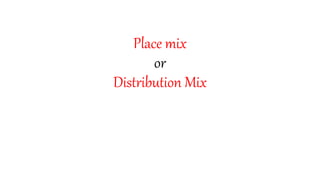Place mix or distribution mix refers to the set of activities and decisions involved in making products available to customers. This includes managing distribution channels and logistics to ensure customers can access the right products at the right time, place, price and manner. Distribution channels involve decisions around channel members like retailers and wholesalers, as well as physical distribution logistics. The goal is to move products from manufacturers to customers in an efficient way that creates value for both parties. Marketing intermediaries like agents, wholesalers and retailers play important roles within distribution channels by linking manufacturers with end users.


















































